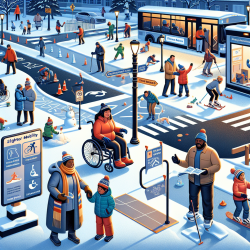Introduction
As practitioners dedicated to enhancing the lives of individuals who use wheeled mobility devices (WMDs), understanding the barriers they face during winter months is crucial. The research article "Exploring Winter Community Participation Among Wheelchair Users: An Online Focus Group" provides valuable insights into these challenges and offers recommendations for improvement. This blog will explore the key findings and discuss how practitioners can apply these insights to improve outcomes for WMD users.
Understanding Winter Barriers
The study identified several environmental barriers that impede community participation for WMD users during winter. These include:
- Weather-Related Barriers: Snow, ice, and cold temperatures create significant obstacles, particularly when sidewalks and curb cuts are not adequately cleared.
- Policy Barriers: Ineffective snow-clearing policies and limited accessible transportation options further restrict mobility.
- Attitudinal Barriers: Lack of awareness and consideration from pedestrians and public officials exacerbate accessibility issues.
These barriers not only limit physical mobility but also have emotional and social implications, leading to isolation and reduced quality of life for WMD users.
Strategies for Improvement
The research suggests several strategies that practitioners can advocate for and implement to enhance winter community participation for WMD users:
- Public Awareness and Education: Educating the public and officials about the challenges faced by WMD users can foster empathy and drive policy changes.
- Advocacy and Coalition Building: Forming alliances with other groups facing similar challenges, such as seniors, can amplify advocacy efforts.
- Policy Recommendations: Advocating for improved snow-clearing policies and accessible transportation options can significantly enhance mobility.
- Technology and Design Improvements: Encouraging manufacturers to design WMDs that are better suited for winter conditions, such as enhanced traction and heated features.
The Role of Practitioners
Occupational therapists and other practitioners play a vital role in addressing these barriers. By leveraging their expertise in environmental adaptations and advocacy, they can drive change at both individual and community levels. Practitioners can:
- Conduct accessibility audits to identify and address environmental barriers.
- Engage in public education initiatives to raise awareness about the rights and needs of WMD users.
- Collaborate with policymakers to develop inclusive and effective policies.
Conclusion
Winter community participation is a right that should be accessible to all citizens, including those who use WMDs. By implementing the recommendations from this study, practitioners can help create more inclusive communities where all individuals can participate fully, regardless of the season. To read the original research paper, please follow this link: Exploring Winter Community Participation Among Wheelchair Users: An Online Focus Group.










